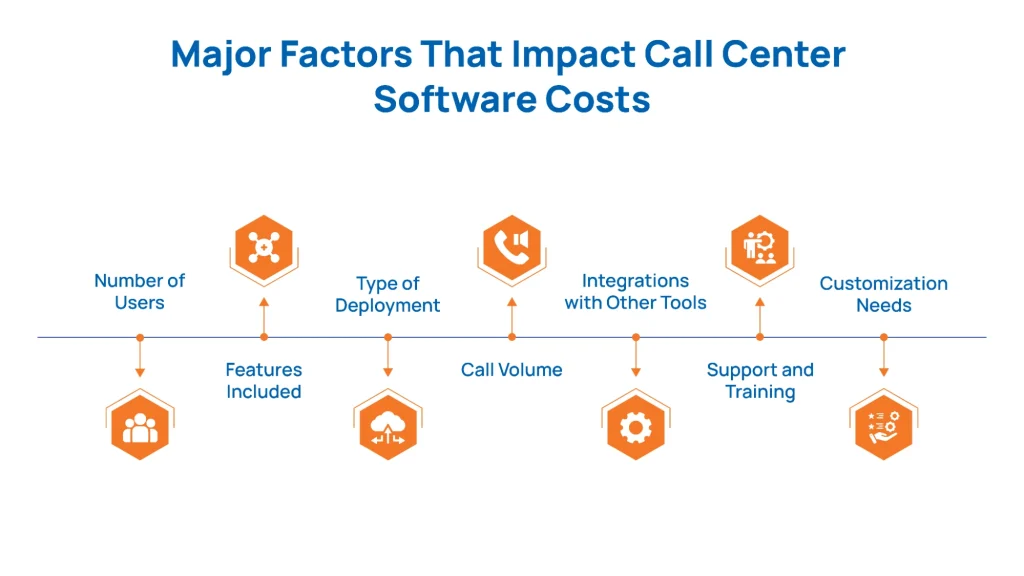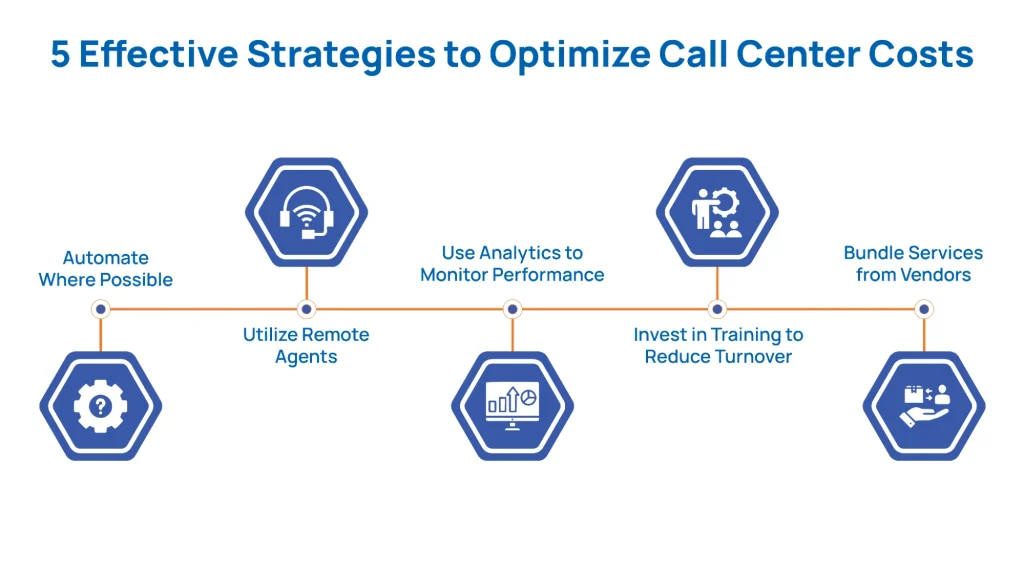Running a call center plays a significant role in delivering excellent customer service, but managing the costs can be tricky. It's not just about the visible expenses like salaries, office space, and phone systems.
What often goes unnoticed are the hidden costs: high employee turnover, recurring licensing fees, or software that doesn’t scale with your business. These less apparent expenses can quietly drain your budget and impact overall performance.
And when things go wrong—unexpected downtime, slow response times, or poor training—it’s not just money at stake. It’s your customers’ trust.
Outsourcing your call center operations to a trusted third-party provider can help you lower overhead, free up internal teams, and gain access to experienced agents and well-established systems that ensure smoother operations and better customer experiences.
PerfectSoft.AI offers an all-in-one, cloud-based contact center platform to reduce cost, simplify operations, and support customer interactions across every channel: voice, SMS, chat, email, and more. This blog breaks down every significant cost of running a call center and how to optimize those costs, avoid common traps, and choose more innovative solutions that scale with your business.
Key Takeaways
- Call Center Costs Add Up: Salaries, software, turnover, and maintenance can make running a call center expensive.
- Understanding Hidden Costs: Running a call center involves more than paying for agents and equipment. Hidden costs like turnover, software, and maintenance can add up quickly.
- Outsourcing vs. In-House: Outsourcing helps reduce costs but offers less control, while in-house operations provide complete control at a higher price.
- CCaaS Solutions: Cloud-based call center software offers a flexible, scalable, and cost-effective alternative, allowing businesses to manage voice, email, chat, and social media interactions from a single platform.
- Optimization Strategies: Automating tasks, utilizing remote agents, and investing in proper training can significantly lower operational costs.
|
Call Center Types: Cost Analysis and Considerations
The cost of running a call center largely depends on the model you choose. Here’s a closer look at the three main types: in-house, outsourced, and cloud-based.
1. In-House Call Centers
An in-house call center means you build and manage the entire operation within your company. You’re responsible for hiring, training, infrastructure, and daily management.
Setting up an in-house center usually involves renting office space, buying computers, phones, and headsets, and installing phone systems or software. You must also recruit and train agents, supervisors, and technical support staff. This can be time-consuming and expensive.
According to Indeed, call center managers make around
$65,297 annually. Apart from staff salaries, you must also account for the cost of training programs and essential tools, including your phone system, call management software, office supplies, and any other resources your team needs to operate effectively.
Operational costs remain high because you cover salaries, office utilities, internet, software licenses, and hardware maintenance. But in exchange, you get complete control over customer interactions, performance standards, and data security.
This model works best for businesses with a larger budget that want to retain direct oversight of their team and maintain complete control over service quality.
2. Outsourced Call Centers
Outsourcing means you hire a third-party provider to handle customer service on your behalf. These providers may be located locally or overseas.
Domestic outsourcing is more expensive but can align better with your brand voice and customer expectations. Offshore outsourcing (commonly to countries like India, the Philippines, or Eastern Europe) costs significantly less, especially in terms of labor. However, language barriers, time zone differences, and cultural gaps can impact the customer experience.
With outsourcing, you don’t need to worry about setting up infrastructure or managing agents. But you also give up control over hiring, training, and monitoring. Quality can vary depending on the provider, and you’ll need clear communication to ensure they represent your brand well.
Outsourcing is cost-effective if you need to scale quickly and manage high call volumes without heavy investment.
3. Cloud-Based / Virtual Call Centers
Cloud-based call centers are run entirely online, using internet-based tools. Agents work remotely from anywhere, and you manage everything through cloud platforms.
There is no need for office space or on-site hardware. Your team logs in through their devices, using software that handles calls, routing, reporting, and customer tracking. You pay monthly fees for these tools, but it’s still far cheaper than maintaining a physical center.
This setup is highly flexible. You can quickly scale your team up or down, making it ideal for seasonal businesses or companies that want to grow without committing to long-term expenses. You also have more control than outsourcing since your agents are still part of your internal team, even remotely.
Cloud-based centers are a strong fit for businesses that want low overhead, fast deployment, and remote-friendly operations.
Major Factors That Impact Call Center Software Costs

When choosing call center software, pricing can vary greatly depending on your needs. Here are the essential factors that affect how much you will pay:
1. Number of Users
Most software platforms charge per user per month. The more agents you have, the higher your total cost. For example, if a platform charges $50 per user and you have 20 agents, that’s $1,000 monthly.
2. Features Included
Basic plans may include call routing. Advanced plans include call recording, CRM integration, analytics, and auto-dialers. Adding real-time analytics, for example, can significantly increase the price.
3. Type of Deployment
Cloud-based software is usually subscription-based with lower upfront costs. On-premise solutions may involve a one-time license fee, server setup, and ongoing maintenance.
4. Call Volume
Some providers charge based on the number of minutes or calls made. Expect to pay more if your team handles high volumes, especially international ones.
5. Integrations with Other Tools
Connecting your call center software with CRMs (like
Salesforce) or helpdesk tools (like
Zendesk) might require custom work or higher-tier plans. These integrations can improve workflow but add to the cost.
6. Support and Training
Some vendors charge extra for onboarding, training sessions, or priority support. If you’re a new team or switching platforms, this can be an added expense.
7. Customization Needs
If you need the software tailored to your specific processes or branding, customization fees may apply. For example, building a custom dashboard or reporting tool can increase your overall cost.
Understanding the Costs of Call Center Software
Initial Setup Costs
Setting up an in-house call center comes with several upfront costs before your team can even take its first call. Here’s a breakdown of what to expect:
1. Facility / Office Space
You will need a dedicated space for your team to work. This means renting or buying office space, paying for utilities (like electricity, internet, and water), and furnishing the area with desks, chairs, and storage.
For example, renting a small office for 15–20 agents in a mid-sized U.S. city might cost $3,000–$5,000 per month, plus $500–$1,000 for utilities and basic furnishings. The final cost depends on your location and how many people you plan to hire.
2. IT Infrastructure
Every agent needs a workstation. That includes a computer, headset, and phone system. You must also install and configure call center software for routing, recording, reporting, and customer data. What to budget for:
- Computers: $600–$1,000 each
- Headsets: $50–$150 each
- VoIP phones or softphones
- Call center software (CRM, auto-dialer, call recording, etc.): $50–$150 per user/month.
|
For example, setting up a team of 10 agents can cost around $10,000 to $15,000 in essential technology and software subscriptions alone.
3. Licensing & Legal Requirements
You will need to make sure your business is legally compliant. This includes getting a business license, meeting local telecom regulations, and following any data privacy laws that apply to your industry.
For instance, if you handle customer health data, you must comply with
HIPAA. If you serve customers in the EU,
GDPR rules apply. Licensing fees can range from a few hundred to several thousand dollars, depending on where you operate and your industry.
4. Recruitment & Onboarding
Hiring your team comes with its costs. You may need to advertise roles, work with a recruitment agency, and run background checks. Once you hire people, you’ll need onboarding materials and initial training sessions.
For instance, hiring and onboarding 10 agents could cost $3,000–$7,000, depending on your hiring process and training needs.
Operational Costs (Monthly/Recurring)
Once your call center is up and running, you'll have ongoing monthly expenses to keep operations running smoothly. Here's what you'll need to budget for:
1. Salaries & Wages
The most significant recurring cost is your team’s pay. What you spend depends on where your agents are located.
In the U.S., a customer service rep earns $2,800–$3,500/month. In the Philippines, it’s about $400–$600/month. In India, wages average around $300–$500/month. In Eastern Europe, it’s usually $600–$900/month.
Besides agents, you’ll also need to pay supervisors, managers, and quality assurance (QA) staff. These roles come with higher salaries. For example, a call center manager in the U.S. might earn $4,000–$5,000/month.
2. Training & Development
Your team needs regular training to stay sharp, adapt to new processes, and deliver consistent service. Depending on the size of your team, monthly refresher sessions or product-specific training can cost between $500 and $2,000.
Certifications—such as those for customer service standards or technical support—may add another $100 to $300 per agent. Even if you manage training in-house, it still requires time, effort, and resources.
3. Software Subscriptions
Call centers rely on various tools to manage calls, track performance, and support customers effectively. Here’s a breakdown of typical subscription costs:
| Type of Subscription |
Pricing |
| CCaaS (Contact Center as a Service) |
$75–$150 per user/month |
| CRM software like Salesforce or HubSpot: |
$25–$150 per user/month, depending on features |
| Helpdesk platforms like Zendesk or Freshdesk |
$15–$100 per user/month |
The total monthly cost can add up quickly if you're using multiple tools. Be sure to plan accordingly based on your team size and specific needs.
4. Telecom & Internet
You will still need reliable
VoIP service and high-speed internet, even with cloud-based systems. VoIP call rates vary depending on volume and destinations. Domestic calls are cheap, but international or toll-free calls can increase your monthly bill. Business-grade internet might cost $100–$500/month, depending on your provider and speed needs.
5. Maintenance & Support
Technology needs regular upkeep. You will need IT support to handle software issues, hardware problems, and updates. IT support staff may be in-house or outsourced. Depending on the size of your operation, expect to spend $500- $2,000/month. Software and system upgrades may be included in your subscription, but some tools charge extra for significant updates or custom support.
Additional / Hidden Costs
Some expenses might not be obvious at first, but they can still have a significant impact. Hidden or indirect costs can add up quickly if you're not ready for them. Here are a few costs you should look out for:
1. Turnover & Attrition
Call centers often deal with high employee turnover; rates can reach 30% to 45% or more. When agents leave, you spend time and money hiring and training replacements. This affects productivity and increases costs.
For example, replacing one agent might cost you $2,000–$4,000 when you factor in recruiting, onboarding, and training. If turnover is high, this becomes a regular expense.
2. Downtime & Outages
Your team can’t take or make calls if your phone system or software fails. Every hour of downtime means lost productivity, possibly missed revenue, or unhappy customers. For instance, a two-hour outage during peak hours could cost hundreds or even thousands of dollars in lost sales or service delays, especially if you’re handling large call volumes.
3. Quality Assurance & Monitoring
A quality assurance (QA) process is essential to maintain high service standards. This often involves hiring QA staff and using software to review and analyze calls. QA team members monitor interactions, provide feedback, and ensure that scripts and procedures are being followed.
Call auditing tools or analytics software, especially those with advanced features like sentiment analysis or scoring systems, can be expensive. While these tools help improve service quality, they also require ongoing investment.
5 Effective Strategies to Optimize Call Center Costs

Running a call center can get expensive, but there are practical ways to keep costs under control without hurting service quality. Here are five proven ways to reduce your call center expenses:
1. Automate Where Possible
Use tools like
interactive voice response (IVR) systems and chatbots to handle simple, repetitive tasks like checking order status or answering FAQs. This reduces the number of live agents needed for basic queries.
For example, instead of paying agents to answer common questions about business hours or return policies, set up a voice menu or chatbot to do it automatically.
2. Utilize Remote Agents
Allowing agents to work from home helps reduce the costs of office space, furniture, and utilities. It also gives you access to a larger talent pool, sometimes in lower-cost regions. For instance, hiring a remote agent in a smaller city or country may cost 30–50% less than hiring someone in a central metro area without sacrificing quality.
3. Use Analytics to Monitor Performance
Track metrics such as call handling time, resolution rates, and agent performance. This will help you identify areas where time or resources are being wasted. For example, if data shows that specific calls take too long, you can adjust scripts or provide focused training to speed things up, saving time and money.
4. Invest in Training to Reduce Turnover
Hiring and training new agents is expensive. By offering better training and support, you can keep employees longer and avoid the repeated cost of recruiting and onboarding. A one-time investment in a structured training program can reduce mistakes, improve service quality, and lower turnover, saving thousands in the long run.
5. Bundle Services from Vendors
Instead of paying separately for phones, software, analytics tools, and support, look for providers that offer bundled solutions at a discount. Choosing a contact center platform like
PerfectSoft.AI, which includes telecom, software, and support in one plan, can cost less than buying each service separately.
Why You Should Consider CCaaS Solutions Over On-Premise Call Center Systems?
Running a call center can be costly. You must pay for office space, phone hardware, PBX systems, and IT maintenance.
Beyond the costs, these call center systems only support voice calls. That means your team can’t respond to emails, chats, or social media messages on the same platform. You use multiple tools, slows down your team and leads to missed messages and frustrated customers.
This means you are often stuck with rigid solutions that don’t scale quickly and require constant updates and troubleshooting.
CCaaS (Contact Center as a Service) solutions offer a more flexible and cost-effective alternative. With CCaaS, you can scale up or down based on demand, saving infrastructure and IT staff money. Here’s why CCaaS solutions are the better choice:
Lower Upfront Costs
With CCaaS solutions, investing in expensive physical equipment like servers or hardware is unnecessary. You simply pay for what you use, reducing the initial financial burden and ongoing maintenance costs.
Easier Scalability
As your business grows or experiences fluctuations in demand, CCaaS allows you to adjust the number of agents easily. You can scale up or down quickly without the hassle of hardware upgrades or long-term commitments.
Better Integration
CCaaS solutions integrate with your existing CRM systems and other essential tools, enabling your team to access customer data and manage interactions smoothly across all channels.
Omnichannel Support
Rather than relying on separate systems for voice, email, chat, and social media, CCaaS consolidates all these channels into one platform. This enables your team to provide a consistent and unified customer experience, regardless of how they reach out.
Ongoing Updates and Security
With cloud-based CCaaS solutions, your system is automatically updated with the latest features, performance improvements, and security patches. This ensures your system remains current, secure, and compliant with industry standards.
Upgrade Your Contact Center Operations with PerfectSoft.AI

Managing customer interactions across multiple channels can be challenging, especially when there’s no centralized system. Agents struggle to maintain consistency without proper tracking, leading to fragmented communication and a poor customer experience.
PerfectSoft.AI solves this by providing a unified view of customer history, seamlessly integrating interactions from email, web chat, phone calls, and more into a single interface. Whether running a high-volume BPO, customer service team, or sales operation, PerfectSoft.AI enables you to connect effortlessly across all channels while maintaining crystal-clear voice communication.
Our Solutions Include:
Omnichannel Contact Center Software: Manage voice, SMS, email, social media, and live chat from a unified platform.
Telecom Voice Services: Ensure high-quality, secure, reliable voice connections, advanced VoIP, and global reach.
Why Choose PerfectSoft.AI?
- Seamless Integration: Connect with your existing CRM and business tools.
- Cost-Effective Solutions: Optimize operations without breaking the bank.
- Scalability & Flexibility – Easily scale your contact center operations.
- 24/7 Support: Get personalized, round-the-clock assistance whenever you need it.
Your contact center deserves technology that keeps you ahead. Let’s transform your customer interactions and voice communications today.
Get Started Today!  When choosing call center software, pricing can vary greatly depending on your needs. Here are the essential factors that affect how much you will pay:
When choosing call center software, pricing can vary greatly depending on your needs. Here are the essential factors that affect how much you will pay:
 Running a call center can get expensive, but there are practical ways to keep costs under control without hurting service quality. Here are five proven ways to reduce your call center expenses:
Running a call center can get expensive, but there are practical ways to keep costs under control without hurting service quality. Here are five proven ways to reduce your call center expenses:
 Managing customer interactions across multiple channels can be challenging, especially when there’s no centralized system. Agents struggle to maintain consistency without proper tracking, leading to fragmented communication and a poor customer experience.
PerfectSoft.AI solves this by providing a unified view of customer history, seamlessly integrating interactions from email, web chat, phone calls, and more into a single interface. Whether running a high-volume BPO, customer service team, or sales operation, PerfectSoft.AI enables you to connect effortlessly across all channels while maintaining crystal-clear voice communication.
Managing customer interactions across multiple channels can be challenging, especially when there’s no centralized system. Agents struggle to maintain consistency without proper tracking, leading to fragmented communication and a poor customer experience.
PerfectSoft.AI solves this by providing a unified view of customer history, seamlessly integrating interactions from email, web chat, phone calls, and more into a single interface. Whether running a high-volume BPO, customer service team, or sales operation, PerfectSoft.AI enables you to connect effortlessly across all channels while maintaining crystal-clear voice communication.


Comments